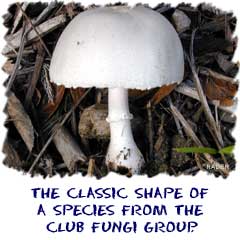
Fungus Among Us
Look into our eyes. Look deep into our eyes. There are no such things as molds. All molds are actually fungi. That's a bunch of fungus. This surprised us when we first learned about it. We always heard about mold in the shower or mold on the bread. Mold is actually a type of fungus. It has a shape called a zygote to be exact. While yeasts are single celled fungi, molds are multicellular fungi. Bread takes one kind of fungus (yeast) to make it rise. If you leave the bread out, another type of fungus comes in (bread mold) to break it down. It's not amazing, but it's true!
Mushrooms
Let's look at Club Fungi first. Mushrooms! Everyone knows about these fungi. So what is a mushroom or a puffball? Bunches of strands living underground are called hyphae (pronounced hi-fah). Those strands are the basic fungus in action, decomposing leaves, or rotting bark on the ground. When it's time to reproduce, they develop a stalk and cap. The mushroom that you see popping out of the ground. It's only one part of the fungus. On the bottom of that cap are a set of gills that have little clubs with fungus spores.Zygotes
We already talked a little about mold. That is only one example of the Zygote Fungi. These have hyphae-like mushrooms but they reproduce in a different way. When it's time to make more fungi, they create a stalk and release something called zygospores (thus the name zygote). When your bread gets old and green or black, you are seeing a type of zygote fungus in action. If you wait long enough, you will see the stalks develop and the zygotes released.
Single Cells
Let's finish up by looking at Sac Fungi, simple, single celled fungi. Yeast is used to make several types of food for humans. We need yeast to make breads. We also use them to make alcohol. It's a whole process called fermentation. Sugars are broken down in an environment without oxygen. It's called anaerobic fermentation. And voila, alcohol. Even though they are single celled, you may find them in colonies. They reproduce very quickly and hang out together. It takes a lot of them (because they are so small) to get a lot of work done.
► NEXT PAGE ON MICROORGANISMS
► NEXT STOP ON SITE TOUR
► RETURN TO TOP OF PAGE
► Or search the sites...
► NEXT STOP ON SITE TOUR
► RETURN TO TOP OF PAGE
► Or search the sites...
Related Video...
Bats in Crisis (US-NPS Video)
Encyclopedia.com:
http://www.encyclopedia.com/topic/Fungi.aspx
Wikipedia:
http://en.wikipedia.org/wiki/Fungus
Encyclopædia Britannica:
http://www.britannica.com/EBchecked/topic/222357/fungus



